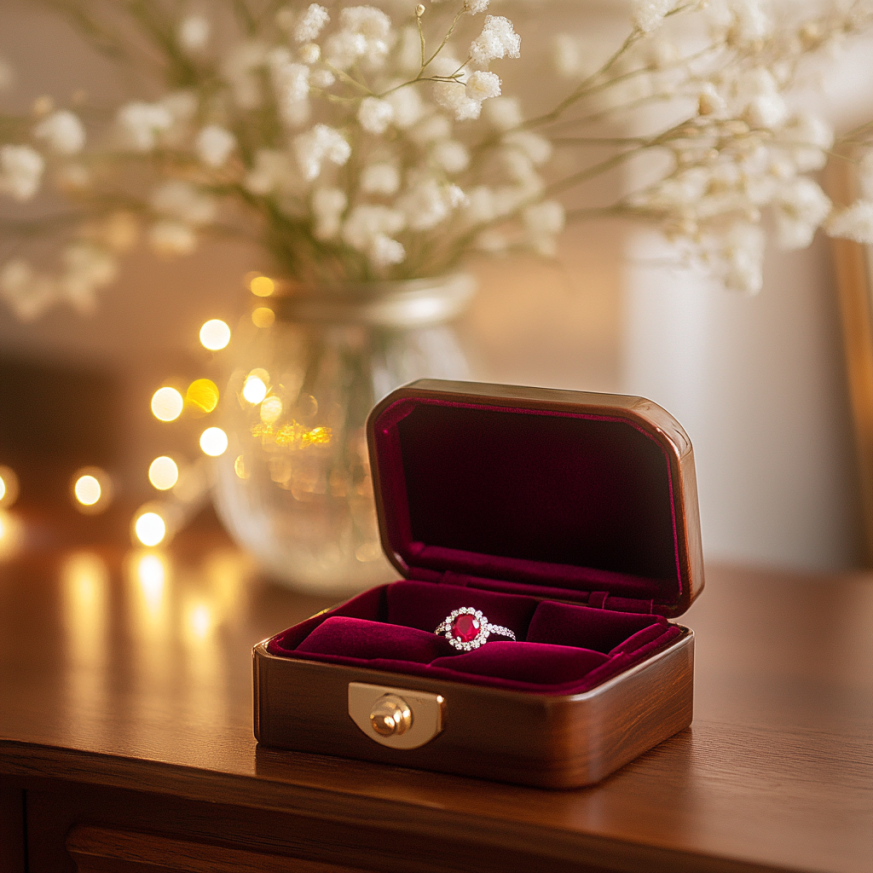Preventing Ruby Wear Damage
Rubies are among the hardest gemstones, ranking 9 on the Mohs hardness scale, but they are not indestructible. Daily wear can cause gradual damage, affecting the ruby’s surface, brilliance, and setting. Preventing Ruby Wear Damage is key to minimizing these effects. Understanding how to Preventing Ruby Wear Damage ensures that your gemstone remains vibrant and well-protected over time.

1. Avoid Hard Knocks and Abrasions
Although rubies are durable, they can still chip or develop fine scratches if struck against hard surfaces.
Best Practices:
- Remove ruby jewelry before engaging in sports, manual labor, or heavy lifting.
- Avoid knocking your ruby against countertops, doorknobs, or hard surfaces.
- Opt for protective settings, such as bezel settings, to shield the ruby’s edges from impact.
2. Keep Rubies Away from Harsh Chemicals
Certain chemicals can dull a ruby’s shine or damage its setting, particularly if the stone has undergone fracture filling or oiling treatments.
Best Practices:
- Remove ruby jewelry before using cleaning agents, chlorine, or acidic substances.
- Avoid exposing rubies to perfumes, hairsprays, and lotions, which can create residue buildup.
- Wipe rubies with a soft, dry cloth after wear to remove oils and chemicals.

3. Choose a Secure Setting for Daily Wear
A strong, well-crafted setting protects a ruby from external damage and reduces the risk of loss.
Best Practices:
- Bezel settings offer maximum protection by surrounding the ruby with metal.
- Prong settings allow more light to pass through but require regular maintenance to ensure the prongs remain secure.
- If a setting feels loose or the ruby shifts, visit a jeweler immediately for adjustments.
4. Store Rubies Properly When Not in Use
Improper storage can lead to scratches, especially if rubies are stored with other gemstones.
Best Practices:
- Store rubies in a soft, fabric-lined jewelry box with individual compartments.
- Keep ruby jewelry separate from diamonds or other rubies to prevent surface wear.
- Use jewelry pouches or soft cloth wraps for additional protection.

5. Clean Rubies Regularly with Gentle Methods
Dirt and dust buildup can cause micro-abrasions, leading to a dull appearance over time.
Best Practices:
- Clean rubies with mild soap, warm water, and a soft toothbrush.
- Rinse thoroughly and dry with a lint-free cloth.
- Avoid ultrasonic and steam cleaners for fracture-filled or oiled rubies.

6. Be Cautious with Treated Rubies
Many rubies undergo treatments such as heat treatment, oiling, or fracture filling, which require extra care.
Best Practices:
- Keep treated rubies away from excessive heat, as some enhancements can break down.
- Avoid soaking treated rubies in cleaning solutions for prolonged periods.
- Request a gemological report when purchasing a ruby to understand its treatment history.
7. Schedule Regular Jewelry Maintenance
Routine professional inspections help identify early signs of wear and prevent major damage.
Best Practices:
- Have a jeweler inspect your ruby’s setting every six months.
- Request a professional cleaning annually to maintain the gemstone’s brilliance.
- If you notice loose settings, scratches, or discoloration, address them immediately.
R12350| play | medium| middle| “8.01 Ct. Ruby from Mozambique”
Conclusion
By following these preventive care tips, you can protect your ruby from everyday wear damage and ensure its lasting brilliance. Avoiding hard knocks, chemical exposure, improper storage, and untreated damage will help keep your ruby jewelry in pristine condition for years to come.
For more details, visit Ruby Ring Daily Care to learn how to keep your ruby ring looking brilliant every day.
